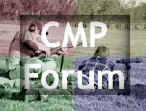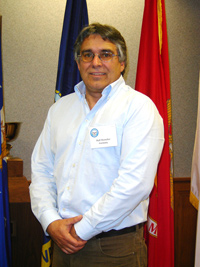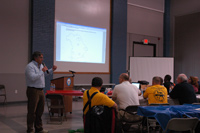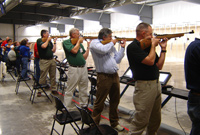

| We want your feedback! Please let us know what you think about TFS. Do you have an interesting story or article that you would like to share? If so, please let us know!
|
Reader Comments:
Regarding the latest update, outstanding work again by the whole CMP crew! New or improved programs, expanded scholarships, new or improved facilities, new rifle and accessory offerings and the super relationships CMP has developed with the ONG and NRA leadership are shining examples of what can be done when one's heart is in the program. You all should be justifiably proud of how the program has progressed into its second century. Somewhere President Teddy Roosevelt has a big grin and is saying a hearty Bully for the CMP! Regards, LTC John F., USAR ret'd
I have truly enjoyed your Shooting Tips site. Even as a 25 yr veteran police sniper/high power shooter,I still find interesting,and useful tips from the successful younger folks coming up through the military,and law enforcement. Keep up the good work!
Det.Tim R.
Wow! Please forward my thanks to everyone responsible for all the improvements I just read about at Camp Perry. Recent years have included quite a few impressive improvements and it looks like there are more this year. The Air Gun range, bath house at RV Park, Bataan Armory remodel, etc are all great. Just letting you know how much we (competitors) appreciate all the work.
Sincerely...
Grayson P.
CMP Shooters' News is one of my favorite email news publications. Information packed, talented authors, timely subjects, and all around well done. What a great service you are providing to the shooting community. Just wanted to say thanks and Merry Christmas.
Newt E.
I enjoy and look forward to TFS and the excellent articles that are published on a regular basis.
Please keep this publication coming and keep the CMP active.
Don M.
One of the members at Snipers Hide pointed out the newsletter and the High Power Tips articles by the USAMU team.
Darn you! I was up until 1:00 AM last night reading all of the articles. Great newsletter and really great USAMU articles.
Thanks,
Michael E.
Great article written on physical conditioning in the latest TFS. I was one of likely many who had asked about the type of conditioning recommended for serious shooters. Sgt. Craig did a great job on describing the routines. Now it’s my turn to put it to work.
Thanks to you, Sgt. Craig and other contributors who share best practices of shooting excellence.
Sincerely,
Keith H.
I use these articles in our high power clinics and have found them very helpful for both new shooters and reinforcement of the basics for the more experienced.
Thanks, Gary M.
Thanks for the great articles on the Carbine, Springfield, Garand matches. All the articles are interesting, but the Carbine, Springfield & Garand are my favorites.
Jim H.
The September-07 on line shooting tips by SSG Tobie Tomlinson, USAMU Service Rifle Team Member, is a great article. I have reproduced 15 copies of it to hand out and discuss to our “newbie” first year air rifle shooters on our high school JROTC Air Rifle Team. Come to think about it believe I’ll hand out a copy to my advance shooters as well. His explanations are simple to understand but rich in detail. Coupled with the sight pictures this article will go a long way towards helping all our JROTC shooters obtain better sight patterns. Keep up the great work. AND…..keep the articles like this coming.
Malcolm V.
CW2 (R), US Army
|
|
|
 |
Bavarian Sport Shooting Federation of Germany Sport Director, Ralf Horneber,
Featured Speaker during the National Youth Leadership Conference
By Steve Cooper, CMP Writer
|
 |
CAMP PERRY, OHIO - The nation of Germany is so familiar to generations of Americans for a number of reasons including ancestral and cultural ties, military assignments and countless books, films, documentaries and television shows featuring German content, yet we're still learning about its people and shooting culture.
At the National Youth Leadership Conference in September, Ralf Horneber, Sport Director, Bavarian Sport Shooting Federation of Germany opened the door to his homeland and its rich sport shooting heritage a little wider.
Horneber enlightened attendees with basic facts like the size and population of his country that came as a surprise to many. Germany, he said, is slightly smaller than Montana in area and its largest Lände (or state) Bavaria, is approximately the size of West Virginia. Germany's population - 82 million, is equal to the combined populations of California, New York, Texas and Wisconsin.
On one hand, Germany is a relatively small country compared to China, Canada or the U.S. to name a few, but on the other hand, there are a lot of people living in a relatively confined area - roughly 600 people per square mile compared to 85 per square mile in the U.S.
Interesting statistics, but what do they have to do with shooting? When you layer the following information over land and population figures, one can envision how sport shooting in Germany has become a highly respected and deeply ingrained part of its cultural and social traditions.
For example, Horneber coaches in a village which has a population of 350 and more than half of the residents of the village are shooters who belong to one of five clubs. He said not all of them are considered high level competitors, but they shoot on a regular basis.
“The backbone of German shooting is found in the shooting clubs. Almost every town or village has one shooting club while larger cities have multiple clubs. It's at the club level that experienced shooters and coaches invest time in instructing junior shooters. Shooting is woven into the fabric of the nation from the grassroots to the national championship level and it's been that way for hundreds of years,” Horneber said.
|

|
|
During his presentation, Ralf reported that the nation of Germany has 1.5 million shooters in 15,000 clubs.
|
The first shooting clubs in the world were formed by German-speaking peoples in the 13th and 14th centuries. At first, bows and wheel-lock muskets were shot from the standing position, but by the 16th century, firearms with rifled barrels were used in public matches. Early club competitions featured festive one-shot matches fired at elaborately painted wooden targets. Matches and shooting festivals for one or more clubs were routinely held on New Year’s Day, religious holidays, and other special occasions. Prizes of gold and money were frequently awarded.
Horneber said traditional prize shooting is still very much a part of the German culture, particularly in Bavaria. It's common for 4,000 shooters of all ages to assemble at events such as the Oktoberfest, where over a two-week period they socialize, celebrate and take part in prize shooting.
In comparison, it wasn't until the early 18th century that Americans saw the first rifled flintlocks capable of putting lead on target with any consistency. Formalized shooting championships didn't happen in the US until the mid-19th century.
“Today more than 480,000 shooters in 4,800 clubs compete in Bavaria alone. About 85% of the shooters in Bavaria compete in air rifle and air pistol and the remainder shoot smallbore,” Horneber said. In total, the nation of Germany has 1.5 million shooters in 15,000 clubs - an average membership of 100 per club.
“Highpower shooting exists in Germany, but on a very limited basis,” Horneber said. Due to population density and the limited availability of land, there are few ranges large enough to handle long-distance highpower shooting.
“Today there are about 20 100-meter and 50-meter indoor ranges for smallbore competition in Bavaria,” Horneber said, “but air gun competition is by far the most popular form of sport shooting in Germany today. Air gun ranges can be found in most villages throughout Bavaria.”
It's fair to say that the demilitarization of Germany after World War II fueled an enthusiastic interest in air gun shooting because the shooting clubs were committed to keeping the shooting sports alive even when firearms could not be possessed for several years after the war.
“Air rifle and air pistol manufacturing skyrocketed in post-war Germany, particularly in the 1950s,” Horneber said. As a result, many German air gun manufacturers and match ammunition providers have risen to prominence, including Anschütz, Feinwerkbau and Walther. Neighboring Austria, a pioneer in air gun technology, is home to Steyr - a leading maker of Olympic air pistols.
As a result of the division of the country in the wake of World War II, East German shooters gained prominence under communist control.
"They were professionally trained under the Communist system, much the way China's shooters are developed today," Horneber said.
“After reunification with the west many former East German shooters began participating in national competition, raising the level of competition in Germany for a period of four or five years,” Horneber said.
Horneber was instrumental in helping develop the rules of a new shooting program, the Bundesliga (federal league), which was introduced about 12 years ago to complement the German national championship program. The league features team competitions in air rifle, air pistol and 18-meter indoor archery.
"The reason we formed the league was to give club competitors an opportunity to shoot high-level competitions during the winter time. The league season starts in October and the top leagues end in February and the lower leagues end a month later," Horneber said.
"It is very popular with the public and all shooters who are interested in shooting in competitions and they get an opportunity to win some money to help pay for their travel and ammunition."
“Bundesliga shooting is fired in a team format where each each team has five team members,” he said. “Members of the team can be women, men, juniors over the age of 18, and older shooters, but the older shooters are not usually good enough to compete in the higher leagues.”
It's a match-play system where shooters compete head-to-head, similar to golf match play.
"There is a ranking system where number one shooters compete with number ones, number twos shoot against number twos and so on," he said. “A team can win up to five points toward their season total. At the season's end, there is a playoff system to determine local, regional and national league champions.”
"It can be very noisy with spectators cheering, shouting - similar to ice hockey," he said. Horneber said Bundesliga matches are shot in a shooting hall in front of 400 to 700 spectators on average and as many as 1,200 spectators in larger regions.
"What has really paid off is that we've opened our teams for one foreign shooter. Four shooters need a German passport and one of them can have a foreign passport - no matter if it's an American or Austrian or Swiss or Russian or Indian," he said.
Horneber said American shooters Matthew Emmons, Jason Parker, Jamie Beyerle, Emily Caruso all shoot in the Bundesliga with German teams.
"Our spectators get to see not only their local heroes, but they can see the other top shooters from around the world."
|

|
|
Ralf, 2nd from right, shoots in the Air Rifle Fun Match during the Youth Leadership Conference.
|
Horneber, 53, a native of Nuremburg and current resident of Kranzberg, has been married to Petra Horneber for 16 years and they have three children. Petra was an Olympic silver medalist in the 1996 Atlanta Games and is the holder of two world championship titles in air rifle.
Ralf started shooting at 10 years of age, which is the absolute minimum legal age to compete in Germany, but he had been going to the shooting range with his father and grandfather since he was three, he said.
Horneber says that while shooting is still extremely popular in Germany, soccer and gymnastics are first and second with shooting in third place in terms of sheer numbers of sportsmen.
"As far as the media are concerned we're definitely not third - we're probably 15th according to them," he said enthusiastically. "We're a second-tier sport compared to soccer, biathlon, basketball, ice hockey and Formula One racing, according to the media," he said.
Compared to American shooting, Horneber said he thinks the key difference lies in the strength of the club system in Germany.
"I think the main difference is the shooting clubs and the shooter's standing in society. Especially in Bavaria, the state where I come from - air pistol and air rifle shooting clubs are a huge part of social life.”
"Of course the distances are not far - the next shooting club may be only two kilometers (1 1/4 miles) away and so they can have club meetings, friendship competitions and league shooting without traveling an awful lot.”
"Maybe shooting is not as integrated in social life in the United States as it is in Germany. I think shooting has developed in a different way in America and in Britain too because there is a long tradition of long-range shooting.”
"I think the shooting disciplines that have developed in our countries have driven us apart because there are quite a number of different disciplines in the U. S. such as full-bore pistol, long range rifle and highpower shooting. International or ISSF (International Sport Shooting Federation) shooting is not as popular in the States," he said.
"In Germany, I think especially as a result of the two world wars, the old traditions were changed to a certain extent and the new situation had to be coped with. That meant that after the Second World War, the first three years, no weapons were allowed at all and then air guns developed. Soon after, smallbore rifles were reinstated.”
"I think that was a really good thing for Germany because with the 10-meter events they could shoot in the basement of a gym or in a shooting club house. I think that's why it was possible to get so many shooting clubs in Germany, it’s due to the development of the air rifle," Horneber said.
“Firearms are not as readily accessible to German citizens. They may only buy a firearm if they've been an active member of a shooting club for one year and must produce documentation showing regular club participation,” Horneber said. “Air rifle and air pistol purchases have no restriction other than a minimum age requirement of 18.”
"Our air rifle clubs are quite respected and the sport is still growing in popularity. It has developed from social life and fun and feeling we are a community. Some shooters who are talented and more ambitious develop out of that with good coaching.”
"Then there are a lot who shoot 20 shots or so one day a week, then they have a beer and play some cards, have some conversation and go home.”
"It is the task of our federation, as it is in America, to find young shooters who are ambitious and who can work hard," Horneber said. "You have to find good shooters between the ages of 10 and 13 and work with them and develop them into good shooters."
NEXT ARTICLE
|
|
|


